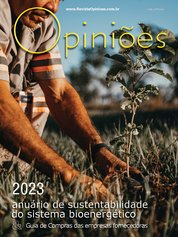Samanta Pineda
Especialista em Direito Ambiental da Pineda & Krahn
AsAA23
O impacto ambiental positivo
Este ano as mudanças climáticas têm realmente se mostrado fortes e imbatíveis. Pela primeira vez na história, rios da Amazônia secaram, enquanto o Rio Grande do Sul e Santa Catarina perderam lavouras, histórias e vidas debaixo de um volume recorde de chuvas. Pedras de granizo do tamanho de um ovo de galinha caíram do céu e o calor fez mais vítimas do que em qualquer outro período registrado. Vulcões, terremotos, tufões e uma lista de eventos climáticos extremos gritaram ao mundo em alto e bom-tom que algo não vai bem.
É certo que cientistas já haviam alertado sobre um “super El Niño” que, além do aquecimento das águas do Oceano Pacífico, provocaria um caos climático de grandes proporções durante este ano. A situação gera grande aflição social e, inevitavelmente, a busca por culpados. Essa culpa, não raramente, recai sobre o Agro brasileiro, o que é um grande e injusto erro.
Enquanto isso, há 27 anos de ocorrência das Conferências Mundiais sobre as Mudanças Climáticas, nações discutem quem paga a quem e quanto cada país, setor e atividade precisa diminuir as emissões de gases que causam o efeito estufa, responsável pelas mudanças climáticas. Fato é que durante todo esse tempo não houve registro de diminuição de emissões. Muito se discutiu e pouco se fez.
O Brasil tem soluções que o mundo parece não querer enxergar. Nossas áreas rurais protegem espaços ambientalmente relevantes que são as margens dos rios, o entorno das nascentes, encostas e outros locais importantes com as áreas de preservação permanente. Temos obrigatoriamente que reservar uma porcentagem que varia de 20 a 80% de vegetação nativa como reserva legal. Onde produzimos, fazemos de duas a três safras ao ano, na mesma área, utilizando técnicas conservacionistas, como plantio direto, sistemas integrados e uso de bioinsumo, ou seja, definitivamente nossa produção de alimentos e fibras são as mais sustentáveis.
É consenso que o grande vilão das emissões é a queima de combustíveis fósseis usados para geração de energia, seja ela elétrica, de transporte, para fins industriais, aquecimento de casas ou outros usos. Enquanto isso, no Brasil, país que emite menos de 3% dos Gases de Efeito Estufa – GEE, do planeta, estamos de vento em popa na produção de energia limpa. Analisando a matriz energética brasileira, facilmente se percebe o diferencial: 47,4% das fontes são renováveis, enquanto a média mundial é apenas 2,5%, segundo dados da Empresa de Pesquisa Energética – EPE.
Na bioenergia, temos o melhor exemplo que ainda se configura caso de economia circular no agro. A cana-de-açúcar é plantada a partir de mudas selecionadas, com grande diferencial tecnológico. Elas recebem a vinhaça, que é um bioinsumo resíduo do processo de industrialização, como fertirrigação, para seu crescimento capta CO2 e fixa no solo.
Depois de processada, com o bagaço é feita a cogeração de energia que tem como resultado o etanol, um biocombustível incrível. De acordo com um estudo publicado pela Unicamp, Embrapa e Agroicone, o cultivo da cana no Brasil eliminou cerca de 9,8 milhões de toneladas de dióxido de carbono (MtCO2) por ano da atmosfera nas últimas duas décadas, o equivalente a 196 MtCO2 no total. As práticas de manejo nas lavouras removeram quase 10 MtCO2 anuais da atmosfera. Já considerando o território agrícola como um todo, e não só as áreas cultivadas, as novas tecnologias contribuíram para a redução de 17 MtCO2 ao ano. Ainda segundo a Unica, de 2003, ano do lançamento dos carros flex, em março de 2022, o uso de etanol evitou que aproximadamente 630 milhões de toneladas de CO2 fossem lançados na atmosfera.
O Brasil precisa definitivamente assumir esse protagonismo e não deixar que estratégias procedimentais internacionais deixem de fora a real solução do problema das mudanças climáticas, que é o uso racional da terra e uma urgente transição energética mundial. Conceitos como o da adicionalidade, que é o impacto ambiental positivo que não existiria caso não existisse o projeto de emissão de crédito de CO2, precisam considerar quem já faz melhor que a média. Aqui no Brasil as exigências legais tornam nossa adicionalidade mais difícil de ser atingida e cabe aos nossos negociadores internacionais mostrarem que deve haver justiça entre os critérios.
Por fim, importante dizer que estamos em processo de regulamentação do Mercado de Carbono Brasileiro. Foi recentemente votado no Senado Federal o PL 412 que cria o Sistema Brasileiro de Comércio de Emissões e que ainda precisa de aprimoramento na Câmara, principalmente em relação à governança, que deve garantir a participação ampla de todos os agentes que puderem colaborar.




